
Chapter 12 of Befriending the Mind:
Our grandson, Henry, is a toddler. When it’s time for him to go to bed, his mom and dad make the world as boring as possible. They quietly put away toys — often he helps. They turn down the lights. They speak in soft voices.
During a recent visit, his mom added another element to the ritual. She picked him up to light a candle as his dad turned off the lights. Carrying him to a second candle, she softly sang, “This little light of mine, I’m gonna let it shine.…” The rest of us joined in. “This little light of mine, I’m gonna let it shine.…”
Henry was totally charmed. He grew still as he savored the glow in the room. “Let it shine, let it shine, let it shine.”

Our singing drifted into silence. Henry was just present, taking it all in. Then he lifted his hands slowly and touched his fingertips together several times. A baby’s ability to mentally understand language matures faster than the verbal ability to articulate sounds. So he and his parents had learned some sign language. He was signing “more.”
We sang more: “Everywhere I go, I’m gonna let it shine.…”
When the verse faded, he seemed to glow like the candles. He brushed his fingers tips down the side of his head — the sign for “sleep.”
“Goodnight, dada,” his mom said for him. “Goodnight grandma. Goodnight grandpa.” He looked at us with glistening eyes. We gently blew him kisses. He snuggled into his mom as she carried him to bed.
How can we describe his state of mind-heart? One label is “luminous, nondual awareness.”
“Luminous, nondual awareness” may sound sophisticated, complex, esoteric, and something for advanced yogis. But it seemed that this was what Henry was experiencing. As I noted in the last chapter (p. 173), nondual awareness is simple, preverbal, clear, agendaless, nonjudging, relaxed, uplifted, and luminous in that it spreads out rather than focuses in. It’s also patiently present with things as they are; and is whole rather than split into past and future, us and them, this and that. It is primal in that it undergirds all awareness though we are usually too busy to notice it. It is simple and innocent.
We might ask, “Where do we find luminous nondual awareness? How can it be cultivated?” The answers are, “It’s right under our noses” and “It can’t be cultivated because it’s already here.” Even a baby can know it. We all know nondual awareness, though we may forget we know.
A familiar Sufi story makes the point:
A man saw his friend searching for something under a streetlight.
“What did you lose?” he asked.
“My key,” the friend replied.
The man joined the search. But alas, they couldn’t find the key.
“Where did you lose it?”
“Inside,” his friend said as he fingered through a tuft of grass.
The man exclaimed, “Inside! Why are you looking out here?”
As his friend looked under a stone for the third time, he replied patiently, “The light‘s better out here.”
In the last chapter we began searching for anatta, one of the Buddha’s most enigmatic teachings. In Pali, the language of the suttas, atta means “self” and an- is a negation. So anatta is usually translated as “not self” or “non-self.”
However, the “self” that atta refers to is not our ordinary, everyday self. It is a “higher self” or “eternal, unchanging soul essence” as described in the ancient Vedic texts.
So when the Buddha created the term anatta, his contemporaries would have understood it to mean “no permanent, timeless, higher self-essence” rather than “no self.” Richard Gombrich translates anatta as “no unchanging self.”[1] This definition of anatta is easier to grasp. But still, the notion slips away easily.
Another way to describe anatta is “everything is process.” Unfortunately, the Pali and Sanskrit languages have no clear word for process. Because it wasn’t in the Buddha’s lexicon, he used metaphors such as “arising and passing,” “impermanence,” and “no unchanging self” to point to what we would call “process.”[2]
Part of the difficulty is not just the words themselves, but the way we use language today. The last chapter explored objective and subjective modes of knowing and languaging and introduced nonduality. Most of our language today is objective. It’s like a bright streetlight illuminating the surface. However, anatta can only be found deep inside. It’s like feeling our way through the woods at night or looking inside a dark room: meaning can be sensed but not grasped.
In this chapter, rather than talk about the various modes of knowing, we’ll step into them. The nondual mode of knowing cannot be adequately explained from outside nonduality, no matter how bright the streetlights. If we want to cultivate night vision, at some point we must step into the dark and give it a try. I’ll begin by describing anatta using the three modes of language: objective scientific, subtle internal feeling, and evocative nondual.
Because anatta is one of the Buddha’s central teachings, various teachers have tried to explain non-self objectively and subjectively. So I’ll begin with objective and subjective descriptions. As you read these, I invite you to pay attention to how your mind feels rather than just to what you think of the subject matter.
First, let’s look at anatta using objective, external, scientific language.
My favorite scientific analogy suggests that self is like a whirlpool. Along the American River where I live, the contours of the bank sometimes turn the water around and force it to flow back upstream for a short distance. When the upstream flow rubs against the downstream momentum of the main river, whirlpools spin off.
I find the phenomena fascinating, even mesmerizing. A whirlpool is a distinctive event, but nothing in it essentially distinguishes it from the river itself. Without the river, the whirlpool could not exist at all.
The center of the whirlpool is nothing — just air or a hole in the water. The center of the whirlpool is empty of whirlpool-ness. Water spins around the emptiness and gives it an undulating shape. The spinning water is no different from the water in the rest of the river. And when the whirlpool moves away from the conditions that caused it to arise — when it spins away from the confluence of the upstream and downstream flows — the energy dissipates, the spinning slows down, the hole fills in, and the whirlpool blends back into the river.
Nothing real is lost. The water is still there. The energy that spun around is still in the river even though it is not spinning in the same way. Even the air remains above the water. The pattern is gone, but all the elements of the pattern are still present.
We are like whirlpools in that everything in our bodies, our thoughts, and our energies comes from the larger river of life. We spin around ourselves in a temporary pattern whose essence is emptiness. When we die, our pattern may be lost — but that was just a temporary abstraction. Nothing that made us up is gone. It goes on in a different pattern. And even when our pattern is strong and apparent, its core is empty.

My second favorite objective description of self comes from the British philosopher Julian Baggini. In a TED talk[3], he projects a circle on the screen with the word “Water” in the middle and asks, “What is water?”
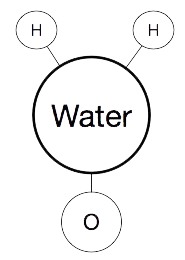
From our high school science, we know that water is made up of two hydrogen atoms and one oxygen atom: H2O. So he adds these to the diagram. Then he asks, “What’s the matter with this picture?”
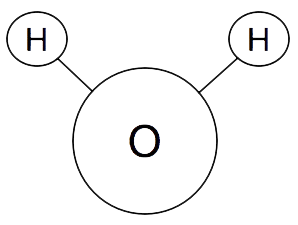
The problem is that the diagram implies that we can take away the hydrogen and oxygen and still have the water right there in the middle. But without those three atoms, there would be no water. In fact, if we take even one of them away, it becomes something very different from water.
So he removes the circle containing the word “Water,” leaving the more familiar diagram of a water molecule.
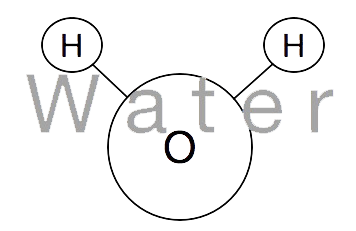
Finally, he superimposes on that molecule the label “Water.” It’s dim and floats over the molecule, indicating that it’s an abstraction. There is no waterness in the water molecule apart from its three elements. “Water” is an umbrella term that refers to a specific configuration. It doesn’t exist by itself. In reality, there are just the atoms arranged as a molecule.
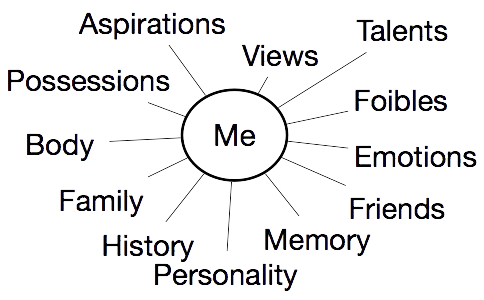
We apply Baggigini’s notion easily to just about everything in life except for ourselves. For example, we know a car is made up of many parts. Take all those parts away, and there is no car. But with self, we might imagine a circle with the word Me in the middle. Connected to it are attributes: body parts, emotions, intellect, memories, neuroses, hang-ups, talents, dreams, fears, and all the rest.
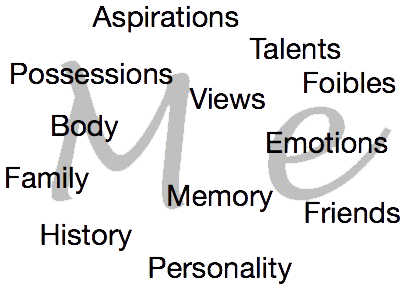
But of course, there is no me-in-a-circle inside us any more than there is water-in-a-circle inside an H2O molecule. If we take those parts away, there is no “me” left. “Me” is just an umbrella term — an abstraction — that points to a collection of qualities. There is no me-ness distinct from its parts.
After reading these objective explanations of anatta, pause and shift your attention from the content of the descriptions to the quality of your awareness. How does the mind feel when it’s in the objective mode? We’ll want to compare this to how the mind feels in other modes.
Let’s shift to the inner subjective mode. What is self like in the subjective realm?
James Finley is an author who trained with Thomas Merton. His mother, whom I’ll call “Sarah,” grew up attending a Catholic academy. She was especially fond of one of her teachers, Sister Julia. They stayed in touch long after she graduate.[4]
Many years later, Sister Julia had dementia and was dying. Sarah went to visit her beloved teacher. It was the Christmas season. She bought a beautiful rosary and wrapped it up as a Christmas gift.
When Sarah went into Sister Julia’s room, the nun was sitting up in bed. Sarah offered the gift to her, “Merry Christmas.” Sister Julia said, “Thank you very much” and placed it on a bedside table.
The two women talked for a while. When the conversation drifted around to the Christmas season, Sister Julia looked at the gift package, picked it up, and said, “I have a Christmas present for you.” Apparently, the nun completely forgot that Sarah had just given it to her.
Sarah accepted the gift. Not knowing quite what to do with it, she just held it in her hand.
Sister Julia said, “Well, aren’t you going to open it?”
So Sarah opened it and pulled the rosary out of its box.
Sister Julia asked, “Do you like it?”
Sarah said, “It’s lovely.”
Sister Julia said, “I’m so pleased. I wanted you to be happy.”
Years later Sarah still treasured that rosary as one of the most precious gifts she’d ever received.
If we look at the story only through external references of objects with simple location, it is the confused nonsense of a demented woman. If we look at it through the subjective realm of feelings and values, it is deeply moving. It is imbued with kindness, generosity, innocence, love, and selflessness. This is what anatta means in subjective, inner experience.
The objective and subjective experiences of anatta are very different. Objective anatta is about physical objects, whirlpools, body parts, and so forth. Subjective anatta is inner experience no matter your psychological condition: emotions, feelings, connection, ease, and so forth.
But the feelings and emotions we associate with the subjective are not what the Buddha meant by “anatta.”
Now let’s try on a nondual, luminous way of talking about anatta. Here, language is not meant to tell us what something is. It is meant to touch an understanding we already have but may have forgotten. It doesn’t try to define anything as much as resonate with a shadowy awareness that is waiting to be acknowledged. The language is poetic and evocative. With our culture’s recent emphasis on external knowing, the art of nondual knowing is under-exercised.
One of the masters of this kind of language was Meister Eckhart, a Christian mystic who was born in 1260 in Germany when nondual Christianity was alive and well.
For example, he wrote:
I am not God.
I am not other than God either.
Let that soak in for a moment.
He was drawing on an ancient tradition called via negativa, or “way of negation.” It posits logical contradictions to confound the objective mind. And at the same time it evokes a deeper, instinctive recognition that each negation has some truth to it: We are God. And we aren’t God. And we are not other than God.
Let those soak in as well.
With modern fundamentalism and all the conflicting ways we use religious terms, words like “God” may be too charged to leave room for the sensing of subtle direct experience.
So here is a contemplation in the style of via negativa and Meister Eckhart that’s been adapted for Buddhists. Relax and see what this language evokes in you:
I am not you,
Neither am I other than you.
I am not the community of creatures,
Neither am I other than all creatures.
I am not the earth,
Neither am I other than the earth.
I am not space,
Neither am I other than space
I am not enlightened,
Neither am I other than enlightened.
I am not a Buddha,
Neither am I other than Buddha.
One of the ways we create a sense of self is to identify consciously or unconsciously with various phenomena. Many of us identify with our thoughts: “They are my thoughts. They are me.” As Descartes put it, “Cognito, ergo sum.” (“I think, therefore I am.”) If we can loosen that identification, we may loosen the sense of a self. So here is a contemplation on thought:
Thinking happens by itself.
Thinking arises.
Thinking vanishes.
I am not thought,
Neither am I other than thought.
I am not the witness of thinking,
Neither am I other than the witness
I am not what’s aware of the witness,
Neither am I other than awareness.
Awareness arises.
Awareness vanishes.
The Buddha did not use via negativa in the traditional Christian style. But he used negation a lot — talking about what things are not. Some of his language can sound obscure unless we drop into the nondual modality.
Don’t get entangled in the literal, objective meaning of the following words of the Buddha from Udana 1.10. Using your spiritual night vision, relax and see what faint impressions they evoke:
Where water, earth, fire, and wind have no footing:
There the stars don't shine, the sun isn't visible
There the moon doesn't appear.
There darkness is not found.
And when a sage through wisdom
has known this for himself,
then from form and formless
from bliss and pain
he is freed.…
Water, earth, fire, and wind are four of the “five great elements” of the Vedic tradition, which the Buddha knew well. They are not to be confused with the modern, scientific elements of the periodic table. In ancient times the water element referred to fluidity and cohesion. The earth referred to solidity. Fire referred to heat. Wind referred to motion. The fifth element was space. So the first line is alluding to space without anything tangible in it — the elements “have no footing.”
To say this differently, space contains everything we can know through the senses. Imagine space with nothing in it. There is not even a source of light — “the stars don’t shine, the sun isn’t visible. There the moon doesn’t appear.” Yet imagine this space being self-illuminated: “There darkness is not found.” This could be called “bright, clear mind” or “luminous mind” that is empty of all things and yet is knowable. It’s illuminated only by itself.
The Buddha is not asking us to employ conventional thinking or logic. When the Zen master Hakuin Ekaku asked “You know the sound of two hands clapping; tell me, what is the sound of one hand?” he was not asking for a scientific demonstration. The language was meant to evoke something we cannot count, weigh, or measure. But we can sense it with spiritual night vision.
Rather than analyze the text logically, we’re invited to let the images seep in and see what they evoke. The Buddha says, when we can do this fully, we are free. We awaken.
The Udana 8.1 presents a similar poem that invites us to go beyond the objective and subjective, and beyond the three highest jhanas — infinite space, infinite consciousness, and neither-perception-nor-non-perception. Our awareness goes beyond all worldly conventions. Notice that the Buddha doesn’t say what this is, only what it is not: via negativa. It is for us to feel our way through that twilight to the end of suffering and to full awakening:
There is that mode where there is neither earth, nor water, nor fire, nor wind;
neither the infinitude of space,
nor the infinitude of consciousness,
nor nothingness, neither perception nor non-perception;
neither this world, nor the next world, nor sun, nor moon.
And there is neither coming, nor going, nor staying;
neither passing away nor arising,
neither coming to be nor change,
without perception.
This, just this, is the end of suffering.
Again, just relax tensions and let these images and what they may be pointing to soak in.
Perhaps the most famous of the Buddha’s nondual texts is the Diamond Sutra of Mahayana Buddhism. Here the word “empty” means that something is empty of itself. For example, a flower is possible because of seeds, soil, rain, sun, and all of nature. Within the flower, there is no flower essence that is separate from the rest of life. The flower is made entirely of non-flower elements. So it exists conventionally, but it has no absolute existence as a separate essence. It is just a temporary configuration that arises out of the web of nature. Relax, settle in, and see what the words evoke:
All things are empty:
Nothing is born, nothing dies,
nothing is pure, nothing is stained,
nothing increases and nothing decreases.
There is no ignorance,
and no end to ignorance.
There is no old age and death,
and no end to old age and death.
There is no suffering, no cause of suffering,
no end to suffering, no path to follow.
There is no attainment of wisdom,
and no wisdom to attain.
Finally, one of the greatest of the Eastern nondual sages was Lao Tzu. He lived and died roughly a century before the Buddha. We have very few of his actual words compared to the volumes of texts attributed to the Buddha. But his language was clearly nondual. Here is an example:
Desires wither the heart.
The sage observes the world
but trusts his inner vision.
He allows things to come and go.
His heart is open as the sky.
True mastery can be gained
by letting things go their own way.
It can’t be gained by interfering.
All things are born of being.
Being is born of nonbeing.[5]
1 Richard Gombrich, What the Buddha Thought (Sheffield, UK and Bristol, CT: Equinox, 2010), p. 9.
2 Ibid. pp. 8–11.
3 See https://www.ted.com/talks/julian_baggini_is_there_a_real_you.
4. James Finley, Meister Eckhart’s Living Wisdom: Indestructible Joy and the Path of Letting Go recorded by Sounds True on June 1, 2014, CD, https://www.soundstrue.com/store/meister-eckhart-s-living-wisdom-5959.html.
5 Lao Tzu, Tao Te Ching, trans. Stephen Mitchel (London: France Lincoln, Lid, 1988), verse 12.
Copyright 2019 by Doug Kraft
This document is licensed under a Creative Commons Attribution-NonCommercial 4.0 International License. You are welcome to use all or part of it for non-commercial purposes as long as you credit the author. Specific licensing details are here.
How to cite this document
(a suggested style): "Nondual Experience" by Doug Kraft, www.dougkraft.com/?p=BefriendNondual.